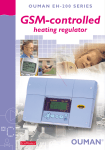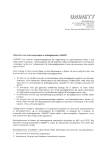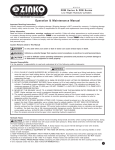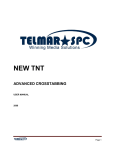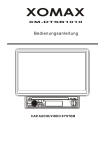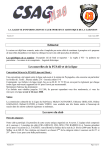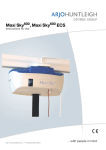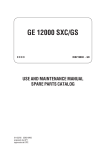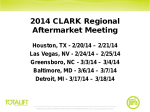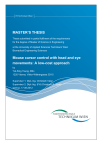Download SXC T - Theseus
Transcript
Tampere University of Applied Sciences Bachelor of Business Administration, Business Information Systems Thesis work Implementation of a digital cross-connect switch to a GSM network testing environment Thesis Supervisor Commissioned By Tampere 03/2010 Lecturer, Master of Science Harri Hakonen Nokia Siemens Networks, supervised by Senior Specialist Mikko Haapaniemi Tampere University of Applied Sciences Bachelor of Business Administration, Business Information Systems Author Thesis Pages Graduation time Thesis Supervisor Co-Operating Company Perttu Haverinen Implementation of a digital cross-connect switch to a GSM network testing environment 39 March 2010 Harri Hakonen Nokia Siemens Networks Abstract Purpose of this thesis was to implement a Nokia Digital Cross-Connect Switch for TimeDivision Multiplexing (SXC T) device to a telecommunication testing laboratory. Thesis work was done in local Nokia Siemens Networks corporation site in Tampere, Finland. SXC T acts as a device that interconnects network elements and enables dynamic, software based switching and creation of circuits. Tasks of device are similar to a typical IP network packet switch, but with enhanced features. It provides the scalability and flexibility which are important attributes for laboratory conditions that are under constant modification. Another goal of thesis was to provide hands on training and device user manual to staff, so they could administer the device independently. Thesis process consisted of phases that serve as a baseline for this document. Second chapter discusses the background of thesis and general information about Nokia Siemens Networks as a company. SXC T is installed to GSM (Global System for Mobile communications) testing laboratory. GSM standard and technology is discussed in chapter three. We also take a closer look at the elements of GSM network that are connected through SXC T. In chapter four SXC T device composition and hardware are reviewed in order to understand device functionality. Planning and execution of SXC T installation, followed by user training are examined in chapters five and six. Thesis outcome evaluation and final conclusions are discussed in chapter seven. As a result of this thesis, Nokia Siemens Networks has a functional digital cross-connect switch in active use. Training and manuals supplied by student guarantee that every user has sufficient know-how for device operation. Documentation is shared in company network drive, so everyone can update material as needed. Backup plan was also created to provide fault tolerance and security for this crucial network equipment. Material used in thesis was mostly device manufacturer documentation, educational books and company slideshow presentations. Many of the solutions were result of hands on troubleshooting and discussion with colleagues. Keywords: GSM, telecommunications, switching Tampere University of Applied Sciences Bachelor of Business Administration, Business Information Systems Author Thesis Pages Graduation time Thesis Supervisor Co-Operating Company Perttu Haverinen Implementation of a digital cross-connect switch to a GSM network testing environment 39 March 2010 Harri Hakonen Nokia Siemens Networks Tiivistelmä Tässä opinnäytetyössä tutustutaan digitaalisen ristiinkytkentälaitteen asennukseen matkapuhelinverkon testausympäristöön. Laite on Nokia Networks Oy:n valmistama Nokia Digital Cross-Connect Switch for Time-Division Multiplexing (SXC T). Työ suoritettiin paikallisessa Nokia Siemens Networks yhtiön toimipisteessä Tampereella. SXC T toimii verkossa laitteena, joka yhdistää eri verkkoelementit toisiinsa ja tarjoaa dynaamisen, ohjelmistopohjaisen käyttöliittymän yhteyksien hallinnointiin ja luomiseen. Laitteen käyttöönotolla mahdollistetaan tyypillisesti muuttumattoman matkapuhelinverkkoympäristön soveltuvuus testauskäyttöön, jolloin siltä vaaditaan erityistä muutosalttiutta. Opinnäytetyöhön kuului lisäksi laitteen käyttökoulutuksen tarjoaminen. Opinnäytetyön toteutus koostui monista eri vaiheista, jotka luovat myös pohjan tälle dokumentille. Johdannon jälkeisessä kappaleessa tutustutaan opinnäytetyön taustoihin, tavoitteisiin ja perustietoon Nokia Siemens Networks yhtiöstä. Koska SXC T asennetaan GSM (Global System for Mobile communications) matkapuhelinjärjestelmän testauslaboratorioon, GSM standardista ja sen toiminnan perusteista keskustellaan kappaleessa kolme. Samalla tutustutaan paremmin myös SXC T:n läpi kytkettäviin verkon elementteihin. Kappaleessa neljä käydään läpi ristiinkytkentälaitteen toimintaperiaate ja kokoonpano. Itse asennuksen suunnittelu, toteutus ja käyttäjäkoulutuksen järjestäminen on sisällytetty kappaleisiin viisi ja kuusi. Työn tuloksien arviointi ja johtopäätökset käydään läpi kappaleessa seitsemän. Työn tuloksena Nokia Siemens Networks yhtiöllä on testauslaboratoriossaan aktiivisessa käytössä toimiva digitaalinen ristiinkytkentälaite. Asennuksen yhteydessä toimitetut käyttöohjeet ja käyttäjäkoulutus varmistavat, että työntekijöillä on valmius laitteen käyttämiseen. Dokumentaatio ja ylläpidettävät taulukot on jaettu yhtiön sisäisellä verkkolevyllä, joten dokumenttien päivitys on vaivatonta. Koska laite on koko verkon toimivuuden kannalta keskeisessä asemassa, sen turvallisuus on varmistettu säännöllisillä varmuuskopioilla. Työn eri vaiheissa käytetty materiaali koostuu pääosin laitteen valmistajan tarjoamista dokumenteista, yleisestä oppimateriaalista GSM verkoista, sekä Nokia Siemens Networks Oy:n yleisistä oppimateriaaleista ja PowerPoint-esityksistä. Monet ratkaisut ovat seurausta perinteisistä ongelmanratkaisumenetelmistä ja keskustelusta kollegoiden kanssa. Avainsanat: GSM, viestintätekniikka, kytkentäisyys Foreword Working on this thesis was a very challenging task. It was demanding to learn and understand the framework of new technology, but implementing knowledge in practice while utilizing the existing network expertise required competence. There were also many setbacks and interruptions during work process. Few times it was even necessary to revert back to factory settings and recreate configuration. Afterwards I am pleased to say that learned skills and experience from such task can provide to be valuable know-how in the future. This thesis report summarizes the main points during the work process. The quickreference guide, user training PowerPoint slides and circuit chart are a part of device maintenance and thus a part of this documentation. These documents can be found as appendices. On behalf of Nokia Siemens Networks, I would like to thank Mikko Haapaniemi, Sakari Ketola, Juha Kuusisto, Toni Honkanen and all other colleagues who were helpful and without whom this thesis could not have been completed in its current state. I would also like to thank Harri Hakonen, who is the supervisor of thesis from Tampere University of Applied Sciences. Tampere March 2010 Perttu Haverinen Table of contents 1 2 Introduction .................................................................................................................... 6 Background information and goals of thesis.................................................................. 7 2.1 Company ................................................................................................................ 7 2.2 Thesis background ................................................................................................. 7 3 Global System for Mobile communication .................................................................... 9 3.1 GSM in brief .......................................................................................................... 9 3.2 Fundamentals of GSM network architecture and operation ................................ 10 3.2.1 Network Switching Subsystem (NSS) ......................................................... 12 3.2.2 Base Station Subsystem (BSS) .................................................................... 13 3.2.3 Network Management Subsystem (NMS) ................................................... 13 3.2.4 General Packet Radio Service (GPRS) ........................................................ 14 4 Nokia digital cross-connect switch (SXC T) ............................................................... 15 4.1 Digital cross-connect switch in a GSM network.................................................. 15 4.2 SXC T Product description and composition....................................................... 15 4.2.1 TDM switching module ............................................................................... 17 4.2.2 Interface module........................................................................................... 18 4.2.3 Operation and Maintenance module ............................................................ 18 4.3 SXC T management and configuration................................................................ 19 5 Planning of SXC T implementation............................................................................. 21 6 Execution phases.......................................................................................................... 26 6.1 Enabling IP connectivity...................................................................................... 26 6.2 Replacing old hardware........................................................................................ 27 6.3 Reworking basic software configuration ............................................................. 28 6.4 Building up new environment.............................................................................. 30 6.5 Graphical user interface ....................................................................................... 31 6.6 Nethawk and monitor connections....................................................................... 32 6.7 Documentation and upkeep.................................................................................. 32 6.8 User training......................................................................................................... 34 7 Conclusions .................................................................................................................. 36 References:........................................................................................................................... 38 Appendices:.......................................................................................................................... 39 Appendix 1: SXC_BSC.xls, circuit chart Appendix 2: NSN SXC T Quick Reference Guid Appendix 3: NSN SXC T Briefing PowerPoint 1 Introduction The demand for mobile communication systems has exponentially increased during past decades. The need for people to communicate and the growing activity of international business has created an ever-emerging market for personal mobile solutions. GSM is the most popular mobile phone standard in the world today. It is used by over three billion people and it is estimated to dominate around 80% of the global mobile market. (GSM Association 2009a) Nokia Siemens Networks (NSN) is one of the world’s leading telecommunications solutions providers today. Working on this thesis begun when student was recruited as summer trainee at local NSN company site located in Tampere, Finland. Regional office of Tampere centralizes mainly on research and development. The department that recruited student performs testing of the hardware and software of a specific GSM network element called Base Station Controller (BSC). Functions of this unit will be explained later. Initially student was given a task to improve the existing testing environment with implementation of a digital cross-connection switch designed for telecommunication networks. The testing environment in the laboratory consists of the same equipment that is used in live GSM networks throughout the world. In short: lots of expensive, space and resource consuming equipment located within relatively small space. Yet it must be adaptable to rapid changes both in hardware and software, which is not what these network components are originally designed for. This scenario creates a burden on test engineers and administrators working with the equipment, because it requires significant amount of effort before full network is configured to match yet another testing scenario. SXC T unit is designed to provide easier equipment management via software based switching of circuits. This obsoletes the need for physically altering the equipment and cables. Necessity of this solution had been known in company for some time, yet it was not until recently that they acquired the proper unit that was capable of digital switching. While the testing department was loaded with other work, the implementation of the SXC T was trusted to summer trainee. Assignment was very challenging due to the student’s own lack of knowledge in the field of GSM networks. However having a strong background in studies in Computer Science and Internet Protocol (IP) was helpful. The SXC T unit is developed by Nokia Corporation and is used by service providers, which means that the command interface and operation of the unit are not designed as user-friendly as compared to commercial network equipment. It also lacks the extensive technical support that is available for standard market products. NSN personnel were not familiar with SXC T equipment. Resolution was that extensive amount of background work had to be done involving GSM technology and SXC T operation. 7 (39) 2 Background information and goals of thesis 2.1 Company In 2007 Nokia Networks and Siemens Communications departments joined operations in order to gain competence and combine know-how from both parties. Nokia Siemens Networks was formed and it is jointly owned by parent companies. Today NSN employs around 60 000 people in more than 150 countries and serves over 600 operator customers. NSN is currently the world’s second largest telecommunications supplier after Ericsson. (Lileg 2009: 2.) Figure 1 displays some major sites and operator customers. Figure 1: NSN global presence and major customer references (Lileg & Rounaja 2009) In Finland, Nokia Siemens Networks has sites located in cities of Espoo, Tampere and Oulu. Tampere site employs around 1100 people and is mainly focused on software specification and testing of 2G and 3G technologies and solutions. 2.2 Thesis background Tampere site has always been one of the company's most important branch offices for research and development. Its multiple stand-alone 2G and 3G mobile network laboratories are used by company internal and external employees, both locally remotely. Remote connections can be created even from other side of the world. Environments consist of all the segments that a live telecom network needs to operate. Though it’s essential to maintain testing laboratory equipment up-to-date with latest hardware and software, usability has not been a top priority when new acquisitions have been made. Until now, testing environments have been rather static and modifications have required a notable amount of effort due to changes needed in cabling. This is not ideal situation for dynamic testing environment, which constantly undergoes rapid changes both in hardware and software to meet the needs for various testing scenarios. Earlier changes in cabling were done locally and manually using a cross-connect patch panel. 8 (39) The solution was to install a Nokia digital cross-connect switch (SXC T) to the laboratory. The device was acquired from another NSN site located in Finland. Once physical connectivity is established to SXC T, the switching and creation of connections, or in other words, circuits, is software based. This means that manual changes to cabling are not needed any more. Every person in the testing team can operate and modify the switched circuits remotely as long as they are connected to the company LAN. 9 (39) 3 Global System for Mobile communication 3.1 GSM in brief Throughout the history people have had various means to communicate with each other from distance. The first portable personal transreceivers were clumsy and were mainly used by authorities and professionals. In Finland, the first introduced mobile wireless technology to gain public popularity was ARP (Autoradiopuhelin) in 1971, which was in use to all the way to the end of year 2000. The system had its peak rate of users in the mid 1980’s, with over 30 000 end users. (Karvonen 2005) While in ARP, once the call was made, the user had to remain within the same geographical area served by the particular base station. If the user would move far enough, the call signal would deteriorate and eventually break up. Next step was the first generation of modern mobile communication system, also known as 1Gor NMT (Nodic mobile telephone). The system was introduced to Nordic countries in 1981. (Penttinen 2000: 11.) It provided feature that allowed users to move freely while talking on the phone, by utilizing automated network cell changes. However NMT was mainly used in Nordic countries, Baltic countries and Russia, while other countries developed standards of their own that would not be compatible with each other. In 1982 the development of a pan-European standard for 900 MHz digital cellular mobile radio was started by the Groupe Spécial Mobile of the CEPT (Conférence Européenne des Administrations des Postes et des Télécommunications). Initially, the acronym GSM was also derived from the name of this group. (Eberspächer, Vögel, Bettstetter & Hartmann, 2009: 5.) (Penttinen 2000: 11.) GSM networks officially launched during summer 1992 and the number of subscribers increased rapidly, such that in the fall of 1993, already more than one million subscribers had made calls in GSM networks, more than 80% of them in Germany. One of the key success factors for GSM was that the standardization work was not fully completed at the time of launch. It was initially decided that GSM would evolve over time. With improvements in computing and radio access technology, GSM will offer continuous improvement and more services. On time these were called “Phase 2” and “Phase 2+” features, which included additional supplementary services, improved short message services and improvements to radio access and SIM (Subscriber Identity Module) cards. (Nokia Networks 2000b: 12.) Today GSM also includes packet switched data transfer method, called GPRS (General Packet Radio Service) and is generally called as 2,5G in order to distinguish the difference between the original, basic 2G GSM functionality. (Penttinen 2006: 14) One of the many reasons why GSM became the prevalent 2G mobile technology was, that during the specification, it was foreseen that national telecommunication monopolies would be disbanded and several competing network operators should exist in each country. The specification determined that GSM was to be an open system, meaning it would contain well-defined interfaces between different parts of the system. (Tisal 2001: 12-13.) This en- 10 (39) ables the equipment from several manufacturers to coexist and hence improve the costefficiency and users would find the cost of calls reducing. GSM continued its success and is still under constant development by many network vendors, including Nokia Siemens Networks. It evolved from pan-European standard to world wide utilization. Although new generation products like 3G/UMTS (Universal Mobile Telecommunication System) and 4G/LTE (Long Term Evolution) are being developed and implemented, GSM is still the most widely used standard for mobile telecommunication. New technologies are not designed to replace, but co-operate with legacy systems. For example, as an end-user, it can be hard to tell whether your mobile is using 2G or 3G. Below is a map of the GSM and UMTS coverage in the world in January 2009 (Figure 2.) Figure 2: GSM and UMTS coverage. UMTS is sometimes referred to 3GSM because of their close technical relationship (GSM Association 2009b) 3.2 Fundamentals of GSM network architecture and operation In order to understand the function of digital cross connection in GSM environment, it is essential to familiarize the basics of GSM network technology. GSM uses Time Division Multiple Access (TDMA), Frequency Division Multiple Access (FDMA) and Frequency Division Duplex (FDD) techniques in its radio interface. TDM (Time Division Multiplexing) is a technology that allows multiple signals or bit streams to be transferred apparently simultaneously as sub-channels in one communication channel, but are physically taking turns on the channel. (Nokia Networks 2000b: 128.) TDMA is an extension of TDM that allows each user to either transmit or receive bursts of information only in the allocated timeslot. (Nokia Networks 2000b: 128.) Figure 3 describes the functionality of TDMA. 11 (39) Figure 3: Data stream consists of TDMA frames. A TDMA frame is further divided into eight time slots (Source: Nokia Networks 2000b: 141) Standard GSM network consists of three subsystems: Network Switching Subsystem (NSS), Base Station Subsystem (BSS) and Network Management Subsystem (NMS). Mobile Stations (MS), or in other words, mobile phones, are needed to be able to use network services. MS is a combination of terminal equipment, or in other words Mobile Equipment (ME) and SIM (Subscriber Identity Module). SIM holds data needed for the subscriber to use the network. Basic GSM network architecture is presented in Figure 4. 12 (39) Figure 4: Standard GSM network architecture and its interfaces 3.2.1 Network Switching Subsystem (NSS) Network Switching Subsystem consists of Mobile Switching Centre (MSC) and the following registers, of which some are optional: Home Location Register (HLR), Visitor Location Register (VLR), Equipment Identity Register (EIR), Authentication Centre (AuC) and Group Call Register (GCR). The subsystem is responsible for call control, charging and mobility management in GSM network. Mobility management is one of they key features in GSM, which aims to monitoring the location of subscribers, so that mobile phone services can be delivered between users regardless of their location. Below is a short description of each of the registers and its function: Visitor Location Register: • Stores information about subscribers in its service area • Temporary database, when a user moves to the service area of a different VLR, the information from previous VLR is erased Home Location Register: • Stores subscribers data and location permanently, location updated by VLR. • Stores SIM card parameters allocated by operator Equipment Identity Register: • Provides security to GSM network together with AuC. A database containing a list of all valid mobile equipment in network. Banned or monitored mobiles are indentified by IMEI (The International Mobile Equipment Identity). IMEI is a unique 13 (39) number sequence located in every mobile and can be therefore used to stop blocked or stolen phones from accessing the network. Authentication Centre: • Authentication and key management Group Call Register: • Enables conference calls provided by GSM network • Not essential but optional for basic GSM network operation. 3.2.2 Base Station Subsystem (BSS) The Base Station Subsystem is responsible for radio path control in GSM. It consists of the following elements: Base Station Controller (BSC), Base Transreceiver Station (BTS) and Transcoder (TC). In NSN Tampere BSC program mainly focuses on BSC feature testing. BSC is the central network element of the BSS and it controls the radio network. Main functions are connection establishment between mobile and NSS, mobility management, statistical raw data collection and signaling support for and Air-interface. BTS is a network component that handles the Air-interface, taking care of Air-interface signaling, ciphering and speech processing. The third component, Transcoder, is used to code speech into right format between network elements. Air-interface speech is compressed to 13 Kbit/s bit rate (full rate) (or 5,6 Kbit/s bit rate (half rate)) from 64 Kbit/s bit rate used in PSTN (Public Switched Telephone Network), which is the standard fixed telephone system used by wired phones. A-bis is the interface between BTS and BSC and uses the same 13 Kbit/s coding as Air-interface. 3.2.3 Network Management Subsystem (NMS) The purpose of Network Management Subsystem is to monitor and administer various functions and elements of the network. Management is implemented by using workstations and databases that are connected to different network elements. NMS has three main functions: fault management, configuration management and performance management. Fault management ensures smooth network operation and rapid fault correction for operators by utilizing various triggers and alarms. Configuration management maintains up to date information about the operation and configuration status of network elements. It is used to monitor the current and possible new configurations of the network. Performance management collects measurement data from individual network elements and stores it in a database. With this data an operator is able to see if its network meets planned performance levels and if there are rapid changes in performance or differences in performance between various areas. 14 (39) 3.2.4 General Packet Radio Service (GPRS) Circuit switched GSM also offered data service, but with inadequate data rates of 14,4 Kbit/s. Later on, an extension was introduced which enabled utilization of three timeslots and a total of 43,2 Kbit/s. Also, the circuit switched nature of the service was far from ideal for bursty data traffic flow. These were the main reasons why standardization for GPRS began in mid 1990’s. (Penttinen 2001: 8-13.) Operators started modifying GSM networks for GPRS compatibility in year 2000. In order to offer packet switched data service, existing GSM network elements required modification and two new elements were introduced. This is also current laboratory setup in Nokia Siemens Networks Tampere site, so we will go through a brief description of each device. Serving GPRS Support Node (SGSN) takes care of the conversion between IP backbone protocols and BSS protocols. In GPRS network topology it’s located between BSC and Gateway GPRS Support Node (GGSN). SGSN also routes data to the right GGSN, performs authentication, data compression and ciphering. SGSN can interact with MSC (Mobile Switching Center) via optional Gs-interface. GGSN can be compared to router in IP network, as it manages similar tasks and hides the GPRS infrastructure from external networks. It enables data packets to be passed on to other packet switched networks, such as Internet, and also allocates IP addresses to mobile stations. The architecture of GPRS capable GSM network is presented in figure 5. Figure 5: GPRS capable GSM network 15 (39) 4 Nokia digital cross-connect switch (SXC T) 4.1 Digital cross-connect switch in a GSM network Today there are different types of digital cross-connect systems. They can be found in Frame Relay, ATM, MLFR (Multi Link Frame Relay) and PCM (Pulse Code Modulation) based networks. SXC T is a digital cross-connect system for circuit-switched networks that uses TDM. TDM was discussed in detail in chapter 3.2. If we compare a digital crossconnect switch to a typical IP network packet switch, the main difference is, that instead of individual packets, it switches circuits. The rest of the operational principles could be considered roughly the same in both devices. Circuits are usually switched for greater time spans, typically months or longer, as compared to packet switches, which can operate on micro- or millisecond time spans. Additional SXC T features include hard-drive-, back-upand file management, alarm management, monitor and test connections and many more. In GSM networks, circuits are switched between network elements such as BTSs, BSCs, MSCs, SGSNs and so on. Digital cross-connect provides redundant, adaptable and high availability environments. It is most effectively used in large network junctions, because it can provide up to thousands of interconnecting ports. (Nokia Networks 2000a: 15.) A device capable of remote administration and switching is a vital feature for operators that have network equipment scattered across vast geographical areas. In GSM, the off-air transmissions are carried out using 2 Mbit/s PCM (Pulse Code Modulation) link method. Physical media can vary from coaxial or optical cable to satellite links and the link protocol used can be for example Ethernet or ATM. (Penttinen 2000: 92.) PCM has been used for digital representation of analog signals since the implementation of digital telephone systems in 1980’s. Single PCM timeslot can transfer traffic at a rate of 64 Kbit/s. European standard for PCM transfer rate is 2 Mb/s (or 32x64 Kbit/s = 2048 Kbit/s). In this case, 32 timeslots are used to carry data. For example the American standard transfer rate for PCM lines is 1,5 Mb/s, since only 24 timeslots are used. (Penttinen 2000: 93.) Digital cross connect switch in NSN laboratory is fitted solely for 2Mbit/s PCM line switching purpose. 4.2 SXC T Product description and composition SXC T is a component manufactured by Nokia Corporation. It is based on the popular DX 200 platform that was developed by Nokia in 1978. DX 200 was the first microprocessor controlled telephone exchange and acted as a digital replacement for analog mobile exchanges. While it has gone through major technical upgrades, it is still being globally used today. SXC T is only one implementation of the platform. Other network elements based on DX 200 design are Nokia BSC, MSC and SGSN. Conversion capability is provided by the possibility to rearrange platform interiors by mounting different cartridges for different purposes. Cartridges contain replaceable plug-in units, which work in conjunction to form computer units, which, in turn, provide the functionality for each platform. Some of these 16 (39) computer units are common to all DX 200 implementations, such as Operation and Maintenance Unit (OMU) and clock. Hardware and fittings of a SXC T may vary, depending on the purpose and environment it is used in. It can be implemented by either using a single- or multiple DX 200 racks. Racks can be interconnected into one logical device in order to increase capacity. In our laboratory, implementation of three racks and maximum of 1024 interface cards is used. SXC T node can be described using module – unit hierarchy. The modules required in each SXC T are the TDM Switching Module, the Operation and the Maintenance Module and the Interface Module, as shown in figure 6. Figure 7 displays the computer units contained by each module. Figure 6: Functional structure of the SXC T node (Source: Nokia Networks 2000a: 20.) 17 (39) Figure 7: Block diagram of the SXC T, displaying computer units in each module. Units drawn using dash line are optional and not used in NSN laboratory (Source: Nokia Networks 2000a: 21.) 4.2.1 TDM switching module The TDM Switching Unit performs switching of internal, incoming, outgoing and transit traffic. It also handles the internal control connections of the SXC T. Line Signaling Switch is an optional computer unit that is used in special timeslot-based switching. This is not used in NSN laboratory. 18 (39) 4.2.2 Interface module Interface module of SXC T consists of 2 Mb/s Interface Units (ET64). A single ET64 can be equipped with up to 32 ET2E plug-in units. An ET2E is a physical card that contains two 2 Mb/s interfaces. Figure 8 displays the principle of the module build-up. Figure 8: Module -> Unit -> Plug-in unit. This hierarchy applies to all DX200 architectures A digital circuit is connected to the TDM Switching Unit via an Exchange Terminal (ET). Exchange terminal performs synchronization of signals and converts and decodes received line code into binary form for switching unit in the incoming interface. Exchange Terminal in the outgoing interface converts the binary code back to proper line code for transfer across physical medium. (Nokia Networks 2000a: 24.) 4.2.3 Operation and Maintenance module The Operation and Maintenance module consists of multiple units, computer units, which have differing tasks. The units are Operation and Maintenance unit (OMU), clock system (CLS), Clock and Alarm Buffer (CLAB), Switch Control Unit (SCU) and Interface Supervision Unit (TSU). The Operation and Maintenance unit allows the remote and local management of the SXC T. It’s the main source for loading software. It also stores performance and accounting statistics, collects hardware alarms and controls switchovers. Switchover is a function where duplicated computer unit, also called a spare unit, can take over the tasks of operating computer unit in case of hardware failure. Operation and Maintenance Unit is also used as the interface unit for any peripheral devices. (Nokia Networks 200a: 4-8.) For fault-tolerant data management purposes, the Operation and Maintenance Unit is always accompanied by a duplicated hard-drive for backup and data management purposes and duplicated power supply. (Nokia Networks 2000a: 27.) In Nokia Siemens Networks laboratory, a special COCEN plug-in unit is used in OMU to enable Ethernet TCP/IP connectivity. 19 (39) Clock system and synchronization are the basis of operation in telecommunication networks. Clock is synchronized throughout the system, as it is needed when PCM signals are decoded and interpreted. (Nokia Networks 2000a: 29.) The Clock Synchronization Unit (CLS) is supplied with an external clock signal from atomic clock or another network device. It supplies the signal to Clock and Alarm Buffer (CLAB), which takes care of alarm reporting and synchronization of other SXC T device racks. Telecommunication network elements have a hierarchy in signal synchronization. Typically MSC (Mobile Switching Center) synchronizes rest of the GSM network devices. All traffic inside GSM network is time stamped and there is a threshold for allowed alteration between clocks. Once this threshold is exceeded, the problems start to arise. This is why synchronization is also necessary in laboratory environment. Switch Control and Interface Supervision Units control the switching network, handle the supervision of 2 Mb/s interface alarms and internal control of the Clock Synchronization Unit. It depends on the size of the node whether the functions are installed on the Switch Control Unit only or distributed between the two mentioned units. (Nokia Networks 2000a: 30.) 4.3 SXC T management and configuration The user interface used in management and configuration of SXC T is called Man-Machine Interface (MMI) and the interface language is Man-Machine-Language (MML). MML is based on the International Telecommunication Union (ITU) recommendations (ITU-T Z.301-Z.341 standards). (Nokia Networks 2000a: 32.) The command interface consists of three different levels. They are command class, command group and individual command. Possible command parameters vary depending on the type of inserted command. From the main menu level, user selects the command class by typing the corresponding letter. The second menu shows the command groups in that command class. The third menu level shows a list of commands in that command group. SXC T main level command menu is displayed in figure 9. Figure 9: The main level menu in MML session 20 (39) There are three different alternatives for managing SXC T: Graphical manager software called SXC T Manager can be used remotely via network or as local stand-alone implementation. The program will be used in NSN laboratory and is discussed it in detail later on. Local Input/output devices, such as printers, terminals or standard PCs may be physically connected to the OMU. The default solution is to use asynchronous serial interface (V.24/V.28). (Nokia Networks 2000a: 33.) Centralized network management allows flexible remote control over node. It can be achieved via a 64 Kbit/s timeslot, X.25 connections from a public data network or a COCEN plug-in unit for TCP/IP connectivity. (Nokia Networks 2000a: 33.) In NSN laboratory, TCP/IP connectivity is enabled by connecting COCEN plug-in unit in OMU to the company LAN IP switch. The management tasks include traffic, fault and alarm monitoring and administration, hardware and software configuration administration and routing and circuit switching administration. 21 (39) 5 Planning of SXC T implementation The purpose of the laboratory in Tampere is to provide means and equipment for testing using live network equipment. Different verification steps and procedures must be carried out before a new software version or technical implementation can hit the global market and live network deployment. Different testing phases require different environments; load testing is performed with thousands of virtual mobile stations hosted by a dozen physical computers. Unit testing makes sure that the internal and external messages that the devices use to communicate are correct in a very detail level. In feature testing, the idea is to test the full system functionality using Mobile Stations, Base Transreceiver Stations, Base Station Controllers, Home Location Registers and so on. The old testing network consisted of multiple independent and static environments with own hardware and software configuration for each tester according to their needs. Testers were working with a BSC and a number of Base Transreceiver Stations connected to it, while the rest of the GSM network was formed using shared components (TC, SGSN, GGSN, MSC, and HLR). The implementation of SXC T was planned in parallel with laboratory equipment rearrangement scheduled to be done during summer holidays. Since equipment was going to be moved and reconnected, no additional work was needed to introduce SXC T to the environment. Originally the move was planned in order to rearrange test laboratories and relocate test engineers offices. Figures 10 and 11 present the logical laboratory environment before and after installation of the device. Note that these pictures are only for illustration while the actual laboratory consists of dozens of BTSs, BSCs and countless mobile phones. 22 (39) Figure 10: Original laboratory environment 23 (39) Figure 11: SXC T implementation 24 (39) In order to achieve proper testing conditions, there must be a possibility to monitor connections and circuits that are created through SXC T. Nethawk is a licensed program used to capture and analyze GSM network traffic from various interfaces. Nethawk is somewhat similar to its TCP/IP counterparts, for example Ethereal. It is installed on a standard PC and capturing is typically enabled by using a switch to duplicate and forward the traffic to the Nethawk port. Monitor connections will be set up through the device, as SXC T is capable of duplicating traffic for testing purposes. At all times during the actual implementation, regular safe copies of the running software configuration must be taken and documented. All the changes made to hardware and software will be documented in order to keep track of changes and possible consequences. After all, nobody in NSN Tampere knew how the device should be configured and operated. Student kept track of the changes by collecting all commands fired and the execution outputs into a notepad file. Planning phase also included the preliminary allocation of SXC T interfaces. Approximate number of needed ET cards and the amount of to be connected devices and interfaces were calculated. SXC T layout and planned ET allocation is described in figure 12 below. Many ET cartridges were left idle for possible future expansions. Figure 12: Layout of the three SXC T racks and planned ET allocation Since the system will be a critical part of the network, it is important to take regular system backups. During configuration, backups were taken after each phase to be able to take a step back in case something irreversible happens. A regular backup policy was to be planned after system configuration is completed. Backups are automatically stored and replicated to both hard disks located in Operation & Maintenance computer unit. Student was also given a task to familiarize with a graphical user interface for SXC T. Stand-alone PC software called SXC T Manager is a program designed particularly for SXC T management. Initial configuration was to be performed using MML because graphical user-interface may lack features. Also in order to understand the system, it was impor- 25 (39) tant to learn principles of command line configuration. Manager may be used later on to perform configuration routines. 26 (39) 6 Execution phases 6.1 Enabling IP connectivity Enabling IP connectivity in order to support easy remote node management was the first task. Using Ethernet cable SXC-T was connected to distribution layer IP switch responsible for connecting all laboratory equipment with the company LAN. Vlan and port descriptions were configured to Cisco Catalyst 2950 switch port. COCEN plug-in unit in SXC T was configured with IP address, subnet mask, default gateway, network frame type, length and allowed protocols (telnet, ftp). Few verification command outputs are displayed in figures 13 and 14. Figure 13: A COCEN plug-in unit settings in operation & maintenance (OMU) computer unit Figure 14: Default gateway, next-hop IP address and link state 27 (39) 6.2 Replacing old hardware Since the device was delivered from another NSN site, it had been used in another network earlier. Hardware and software configurations were left untouched. Student needed to remove and uninstall hardware that was of no use in our laboratory, so it would be possible to replace it with new parts. Before committing any changes, old system configuration was saved and documented for future guideline. Computer units were left in place, but most of the Exchange Terminal (ET) cards had to be changed. Old environment was using coaxial cable connectors, while we were using Euro-type connectors in our PCM cable ends. ET cards of wrong type and circuits that were connected to them were removed. New ET cards were mainly acquired from the old, unused BSCs. We also had to check that strapping pins on new cards would match those on the old ones. Pins control for example frame and signal processing. Below is a photo of an ET2E card. Strapping pins and Euro-type connector are marked to the picture. Figure 15: Euro type –connector ET card (ET2E) After physically mounting the cards, they had to be manually created in software and connected with the line-up using MML interface. There is no “plug-and-play” feature. For example card’s physical location, index, track, type, mode, supervising unit, supervising PCM and timeslot numbers had to be allocated manually. Device manuals and the preceding configuration acted as instructions for configuring the new hardware. First backup (fallback copy) from system state was taken after all old ET cards were replaced with new ones. 28 (39) 6.3 Reworking basic software configuration After new hardware was in place and installed, the rest of the old configuration was to be erased. Idea was to start from clean environment, so that we could rule out the possibility of old configuration errors affecting the newly created set up. Original plan was to find and install new, blank operating system for SXC T after the ET cards were replaced. Despite of searching manufacturer databases and company network storages, we failed to recover a version with correct software build. It was decided that old configuration should be erased in order to correspond a clean install. This included erasing and recreating all circuit groups. All ET interfaces in SXC T belong to a circuit group. Circuit group type, number, name and participating ET’s can be modified. Student decided to assign the interfaces that connect to similar network elements in same groups. This required utilization of the ET allocation plan that was created earlier. All ET types, modes and states were reverted to transparent mode. A transparent network element does not modify traffic that passes through it, but only forwards it accordingly. It is invisible to other devices in the network. It’s the most simple and efficient way to operate SXC T. All of the 32 timeslots in single PCM line in outgoing interface are transmitted exactly the same way as they were received in the incoming interface. This enables switching of whole PCM lines (32 timeslots) instead of individual timeslots, which is required only under special circumstances. All ET’s were initially offline and were powered on along the way, because an ET2E unit that is up and running but has no connection causes “Signal Missing” alarms to alarm log. In this step we also set clock synchronization, which is a vital feature for all telecommunication network elements. We decided to wire an independent signal cable from atomic clock into the clock synchronization interface located on top of SXC T rack. Verification output of synchronization state and clock time is displayed in figure 16. 29 (39) Figure 16: Correct date and hierarchic synchronization state revealed that synchronization was correctly configured One of the biggest concerns were erroneous unit states and alarms in SXC T. One SCU (Switch Control Unit) was not working and the unit state was faulty. Another SCU was working, but since the idea of having two units is to provide fault tolerance and automated switchover capability if other unit fails, it was important to get it fixed. Also, Operation and Maintenance unit (OMU) suffered instability issues by randomly performing system resets. Computer units can be forced to undergo diagnostics in attempt to locate origins of the fault. Below is an example of deliberate error creation and troubleshooting on TSU-1 (Trunk Supervision Unit, index 1). This was caused by pulling out a plug-in unit and resetting the computer unit. Figures 17, 18 and 19 display the alarms and unit states caused by this error situation. Figure 17: First symptoms of a failure are the notifications in system alarm log 30 (39) Figure 18: Unit state can be verified from working state interrogation Figure 19: TSU-1 diagnostics pinpoints the physical location and index of the faulty plug-in unit Troubleshooting mentioned problems required time and effort as student ruled out the possible causes of malfunction with the help of other test engineers. Finally it was discovered that a faulty plug-in unit was causing the SCU to fail and when comparing the cabling chart with device cabling, we found out that OMU plug-in unit had one cable connected incorrectly. After system was stable, a backup was taken. At this point, backups were named according to date and there was a simple separate documentation about prevailing system state in each backup. 6.4 Building up new environment Next it was time to start building physical and logical connections. Initially student was given one BSC and two BTS’s to test things out before full-scale implementation. This way it was easy to spot possible errors and fault situations in different scenarios without affecting the ongoing testing. With help from staff responsible of laboratory equipment, student connected these tree network elements to SXC-T using PCM cable, two cables from BSC and one from each BTS. SXC T ET’s were powered up and a transparent, bidirectional connection was established between links. With help from test engineers, student also per- 31 (39) formed BTS and BSC configuration to be able to confirm correct link functionality on both end devices. After a successful trial, laboratory staff commenced full scale physical device connections through SXC T. Once again, a backup was taken before any further steps. Student was left with task of documenting and creating all circuits that would pass through device. 6.5 Graphical user interface Software designed for SXC T management was acquired from Nokia Siemens Networks site in Espoo. It’s called “Nokia SXC T Manager”, version C3.1. Setting up the manager was easy and the instruction manual that was delivered with software was well-defined. First the program was supplied with device IP address. When connection was established, program automatically detected available ET’s, computer units and their statuses, existing circuits, alarms and so on. While manager included most of the routine configuration tasks, including ET mode and state changing, monitor connection and alarm log handling and circuit managing, it soon became clear that it lacked many fundamental configuration options. These were for example computer unit management, diagnostics, circuit group, backup, file- and operating system management. Figure 20 is an example view of program main window. Figure 20: Example of graphical view of ET statuses and connected circuits. ET’s are indentified by index numbers Despite of its defects, SXC T manager was well fitted for daily administrative tasks like creation and deletion circuits. Therefore student decided to teach test engineers in both operating the device via MML and manager program. This way everyone could adopt the way they personally find most suitable. User training is discussed later. 32 (39) 6.6 Nethawk and monitor connections Finally when all lines were physically connected and circuits created between them, it was time to set up monitoring connections. 32 ET cards in one ET64 cartridge were sufficient for this purpose. Nethawk PC’s were installed to a shelf behind SXC T and they were connected to company LAN for Windows remote desktop connection. Each computer was equipped with a Nethawk NAP Adapter connected to motherboard PCI-bus. Two PCM lines could be monitored through one adapter, so each PC reserved one ET2E card (two ET interfaces) from SXC T. SXC T has a feature of echoing traffic from selected circuit to a specific ET port for monitoring purposes. In case of two ET interfaces, traffic from other network element is forwarded to the other ET interface and vice versa. Both the target ET and monitored circuit can be easily configured to any desired interface. Monitoring could be handled both using MML and SXC T Manager program. However handling monitor connections in Manager program was rather complicated. Example output of a created monitor connection is displayed in figure 21 below. Figure 21: Monitor connection for circuit ÉT 66 – ET 556 is forwarded to ET interfaces 402 and 403. A total of 5 monitor connections currently exist on device 6.7 Documentation and upkeep Environment was finally fully operational. Although there were problems and delays in different phases of implementation caused by inexperience and hardware issues, work was still in schedule. However documentation was currently based on temporary notes for most part and needed contribution. Circuit chart was planned to be made on Excel sheet and then shared in company’s network drive. After SXC T user training, each test engineer could keep the sheet updated for circuits they manage. Updated documentation is a vital part in order to keep track of circuits and connections. Circuit chart for this SXC T device was created by student and is included in thesis as Appendix 1. 33 (39) To avoid irreversible node failure or invalid configuration causing instability, there was a need for a backup plan. Backups taken irregularly without any control or documentation would not provide required degree of security. SXC T like BSC’s and other DX200 platform equipment include a command calendar option which can be used to assign scheduled tasks. However the matter is problematic; SOMAFI is a file that contains indexes for all the created packages in a DX 200 platform. It allows only eight system backup packages to exist simultaneously, even though hard-drive was far from full. Because of this, taking automatic backup for example every two weeks would fill SOMAFI index very quickly. There is also an option for “DATA” incremental type backup, which overwrites data files and saves settings without creating additional directories. However on the long run, only one updated backup would be insufficient and possibility of corrupted package would be far too large. Matter was discussed among student and test engineers and solution was to commence automatic incremental “DATA” backup using one directory, and to manually take and document a “FULL” backup to another directory every two months for increased security. Also, we took a foundational backup called “MASTERFB” (FB, Fallback) from current system state that would not be overwritten. This way the possibility of a corrupt backup file and forced rollback to a file that is not up to date is minimal. A backup copy command execution is displayed in figure 22. Figure 22: Command execution of a full backup file named MASTERFB For a continuous, scheduled backup task, multiple steps had to be taken. First we needed to create a file containing the command that could be attached to command calendar, also known as command file. This file can be seen in figure 23. In figure 24 the created file is attached to command calendar and assigned with execution date, time, interval and number of executions. You can also see the other definable parameters. We decided to roll the backup on Friday 23:00 every other week, on a non-business hour, with infinite number of executions. 34 (39) Figure 23: The command ”ZWKS” is used to create an incremental backup of data files (type = DATA). A command file called ”DATAFB.CMD” was created Figure 24: Command calendar execution parameters 6.8 User training Though device manuals were already supplied with SXC T, there was a demand among test engineers for a simple quick user guide that would include all the basic SXC T commands. These were deletion and creation of circuits and circuit groups, monitor connections, handling of ET modes, states and settings. Student decided to introduce the usage of both MML and graphical Manager program. On some occasions however, using SXC T Manager was not feasible because of the additional phases required when compared to a single MML command. Based on opinions from colleagues, user guide document was to be a rather simple explanation of each command accompanied by screenshots for clarification. User guide is attached to thesis report as Appendix 2. In addition to the quick reference guide, student was asked to make a short presentation to all test engineers so everyone would know how to configure circuits and ET’s on their own. 35 (39) The presentation itself was a very educational as much for student as it was to audience. Key features of equipment were introduced and among the user guide, a PowerPoint presentation served as a backbone for the presentation. It lasted for about an hour, and questions from listeners were answered during it. The PowerPoint is attached to thesis as Appendix 3. 36 (39) 7 Conclusions Thesis goals were to have an operational SXC T digital cross connect switch in testing laboratory by August 2009. Circuits in switch were to be functional and management was to be remotely done using company LAN. Test engineers should have a sufficient level of knowledge in order to operate the device. Device maintenance plan and documentations would provide security and ease of maintenance for the future. The most challenging time during the process was the beginning. I was given a fair amount of technical details and manuals that I could barely understand. While trying to figure out the layout and details of the device configuration, I finally decided to put device documentation aside and start from the basics. I grabbed myself a Nokia GSM System Training book and studied GSM network technologies in general with help of colleagues. I also observed testing and GSM data monitoring with other test engineers, which also helped me in getting familiar with the system. Support from outside was a vital part throughout the implementation and it was necessary to discuss with people responsible for the configuration of other devices. Documentation and material used by student during thesis work was mostly manufacturer device documentation supported by books and training materials about GSM networks and technology. Therefore the overall material can be concerned fairly reliable, as it’s mostly facts about GSM standard and its history, leaving no room for interpretation. Device specific documentation produced by SXC T manufacturer, Nokia Telecommunications is also from reliable source and up to date. Few used online sources include publications from notable Finnish universities and world wide GSM association and are written and inspected by persons with adequate level of knowledge before publication. There were numerous problems and standstills during work process. Both student and test engineers were unaware of certain configuration parameters and their purposes. Support was also asked from other NSN sites and company external sources, like Nethawk Corporation, when the case was that traffic monitoring tools in SXC T were not working properly. Two of the time consuming problems were due to faulty internal cabling configuration, which was solved with help of members from team that was responsible of laboratory equipment and hardware. Though device manuals were of good quality, there was no way the work could have been solely based on them. Few delays were caused by late hardware and cabling equipment shipments from third party vendors as well. In all, targets were achieved in schedule, right before new software release was about to enter testing phase. There were some pressures concerning completion of thesis during final stages, because testing could not be started before digital switch connecting the test environments was fully up and running. At this point student decided to make the SXC T operational first. Future usage and time span of device is yet unknown. However such a major change in environment wouldn’t have been carried out if it was for short term use only. Though some might consider SXC T another possible source of errors in network topology, it is well known for its stability once it is fully operational. It needs no additional maintenance excluding manual backups. Once IP technology is taken further into 2G technology, it obso- 37 (39) letes the need for PCM digital switch. However this will not happen in the next few years to come and legacy testing is still needed for much greater time span. Nokia Siemens Networks is a multinational company. The reason why thesis was written in English was that it could be used as a guideline in possible future SXC T installations. Soon after our device was operational, installation of another SXC T begun in adjacent testing department in NSN Tampere. Documents written by student were helpful guidance and some on-site configuration support was also provided. This example proves that thesis documentation written in English can be used as a guideline during possible future installations in NSN sites all around the globe. Student himself was very pleased with result of thesis in total. In addition to successful work outcome, the process was very educational. As the trend today is to unite different network technologies and areas to work in one operational IP network core, knowledge of both telecommunication and IP networks is very useful. Also the thesis was important to employer and therefore the motivation to finish it fully completed and in schedule was high. Command line interface and individual commands are not explained elaborately in documentation. This purpose is served by additional user guide created by student, which is attached to this thesis as Appendix 2. However it is designed for test engineers that are already familiar with GSM technology and GSM network equipment configuration. Student didn’t find it relevant to explain the diverse configuration parameters and MML commands in detail to reader. 38 (39) References: GSM Association 2009a: GSM World: Market Data Summary. [online] [referred 18.06.2009] http://www.gsmworld.com/newsroom/market-data/market_data_summary.htm GSM Association 2009b: GSM World Poster 2009A. [online] [pdf] [referred 25.06.2009] http://www.gsmworld.com/roaming/GSM_WorldPoster2009A.pdf Lileg, Ruth, 2009. Nokia Siemens Networks market leadership. [pdf]. Nokia Siemens Networks. Lileg, Ruth & Rounaja, Saara, 2009. Nokia Siemens Networks company presentation June 2009 3b. [ppt]. Nokia Siemens Networks. Karvonen, Erkki, 2005. Johdatus viestintätieteisiin – Viestinnän historiaa – Sähköisen median historiaa. [online] [referred 24.06.2009]. http://www.uta.fi/viesverk/johdviest/viesthistoria/sahkomedia.html Eberspächer, Jörg, Vögel, Hans-Jörg , Bettstetter, Christian & Hartmann, Christian 2009. GSM – Architecture, Protocols and Services, 3rd edition. United Kingdom, West Sussex: John Wiley & Sons, Ltd. Penttinen, Jyrki 2000. GSM-tekniikka – Järjestelmän toiminta, palvelut ja suunnittelut. 2nd edition. Helsinki: WSOY. Penttinen, Jyrki 2001. GPRS-tekniikka –Verkon rakenne, toiminta ja mitoitus. 1st edition. Helsinki: WSOY. Penttinen, Jyrki 2006. Tietoliikennetekniikka – Perusverkot ja GSM. 1st edition. Helsinki: WSOY. Tisal, Joachim, 2001. The GSM Network – GPRS Evolution: One Step Towards UMTS. 2nd edition. United Kingdom, West Sussex: John Wiley & Sons, Ltd. Nokia Networks 2000a. SXC T – Service Cross-Connect for Time-division multiplexing – Product Description. Nokia Networks Oy. Nokia Networks 2000b. SYSTRA – GSM System Training. Nokia Networks Oy. 39 (39) Appendices: Appendix 1. SXC_BSC.xls, circuit chart Appendix 2. NSN SXC T Quick Reference Guide Appendix 3. NSN SXC T Briefing PowerPoint slides BSC Bon Bon Bon Bon Bon Bon Brian Brian Brian Brian Brian Brian Elisa Elisa Elisa Elisa Elisa Elisa Elisa Elisa Elisa Elisa Elisa Elisa Elma Elma Elma Elma Elma Elma Hanna Hanna Hanna Hanna Hanna Hanna Hanna Hanna Hanna Hanna Hanna Hanna Heidi Heidi Heidi Heidi Heidi Heidi Heidi Heidi Heidi Heidi Heidi Helga Helga Helga Helga Helga Helga Helga Hulda Hulda Hulda Hulda Hulda Hulda Hulda Jenny Jenny Jenny Jenny Jenny Jenny Kummola Maija Maija ET 32 33 34 35 36 37 32 33 34 35 36 37 256 258 260 262 264 266 268 270 272 274 276 278 257 258 259 260 261 262 512 513 514 515 516 517 518 519 520 521 522 523 1073 1074 1075 1076 1077 1078 1079 1080 1081 1082 512 32 33 34 35 36 37 256 258 259 1072 1073 1074 1075 1076 1077 256 256 257 SXC 166 167 168 169 170 171 172 173 174 175 176 177 192 193 194 195 196 197 198 199 200 201 202 203 160 161 162 163 164 165 118 119 120 121 122 123 124 125 126 127 130 131 145 146 147 148 149 150 151 152 153 154 144 SXC 458 230 573 582 576 468 288 480 580 577 464 467 229 517 518 519 520 521 522 523 524 538 226 525 526 570 462 527 528 529 531 532 533 545 561 547 548 457 94 450 95 513 96 554 97 570 98 571 99 228 100 452 102 (-> 510) - (511->) 563 103 184 481 185 186 187 188 189 482 461 178 459 179 289 TCSM TCSM2i 11 MSC Liisa BTS SGSN Media Gateway 556 Netta 790 Leevi 32 Metro-123 Ultra 60 Metro 55 TCSM3i 5 Liisa 562 ET 7 Talk 14 Metro 44 TCSM3i TCSM3i 1 129 Liisa 551 Cabinetmaster Flexi 102 Flexi 102 Flexi 102 Flexi 102 Flexi 102 Flexi 102 Flexi 102 Flexi 102 Ultra 83 1 2 3 4 5 6 7 8 Flexi 206 Flexi 206 Flexi 207 1 2 1 Ultra 95 Ultra 95 Ultra 95 Ultra 82 Ultra 82 Ultra 82 Ultra 120 Gemini Ultra 121 Ultra 121 1 2 3 1 2 3 1 Netta 789 Netta 786 Netta 788 TCSM2i TCSM3i Liisa 563 TCSM2i Liisa 532 Flexi 103 Ultra 80 Flexi 207 Flexi 207 TCSM2i Liisa 1 2 1 2 536 Ultra 84 ET 8 TCSM2i 12 Liisa Liisa 564 553 Leevi 33 Maija Maija Maija Maija Sonja Sonja Sonja Sonja Sonja Taru Taru Taru Taru Taru Taru Tellervo Tellervo Tellervo Tellervo Tellervo Tellervo Tellervo Ulla Ulla Ulla Ulla Ulla Ulla Ulla Veera Veera Veera Veera Veera Veera Veera 258 259 260 261 32 33 34 35 36 32 33 34 35 36 37 512 513 514 515 511 512 513 515 516 517 180 181 182 183 70 71 72 73 74 64 65 66 67 68 69 105 106 107 108 109 110 111 132 135 256 82 258 259 260 84 85 86 - 581 584 578 579 460 - 562 515 227 537 231 451 Ultra 99 Flexi 109 Metro 27 Metro 69 Liisa 524 Ultra 81 TCSM2i Liisa 556 557 224 225 Ultra 126 Ultra 126 466 544 549 TCSM3i 465 TCSM3i Liisa 791 Netta Netta 784 785 Netta 787 1 2 552 Ultra 2000 Ultra 117 Liisa 554 530 456 Netta 535 Ultra 77 TCSM2i Liisa 1 520 Ultra 111 Flexi 104 1 (18) Appendix 2. NSN SXC T Quick Reference Guide Pages: 18 2 (18) SXC T Service Cross-Connect for Time-divison Multiplexing Quick Reference Guide 3 (18) 1.0 Using MML....................................................................................................................................5 1.1 ET Configuration .......................................................................................................................5 1.2 Circuit groups.............................................................................................................................7 1.3 Cross-connections ......................................................................................................................8 1.4 Monitor connections ..................................................................................................................9 1.5 Cocen TCP/IP ..........................................................................................................................10 2.0 SXC T Manager C3.1...................................................................................................................12 2.1 Setup and install .......................................................................................................................12 2.2 Configuring ETs.......................................................................................................................14 2.3 Cross-connections ....................................................................................................................16 3.0 Backup policy ..............................................................................................................................18 4 (18) 5 (18) 1.0 Using MML 1.1 ET Configuration Step 1. Creating ET plug-in unit Et plug-in units are created with ZWTP command. ET number, track, index, function, bandwidth, PCM and timeslot options must be configured. Even ET’s require an additional control PCM, while the odd ET’s are configured with only one PCM. Control PCM number is cartridge based and timeslot corresponds to the track number. The other PCM number corresponds to ET number and used timeslot is 0. ZWTP:ET,98:ET2E,0,17::ETT00,4,12,TSL,17:ETT00,4,98,TSL,0:; ZWTP:ET,99:ET2E,0,17::ETT00,4,99,TSL,0:; ET ET ET ET ET ET ET ET ET ET Type = ET2E Index = 0 Control PCM function = ETT00 Control PCM bandwidth = 4 Control PCM number = 12 Control PCM timeslot = 17 PCM function = ETT00 PCM bandwidth = 4 PCM number = 98 PCM timeslot = 0 Verification: ZWTI:P:ET,98:; Step 2. Connecting ET’s to lineup After creation of ET’s, they must be connected to the lineup using command ZWUC. ET index, type and signalling type must be defined here. ET type is typically ET2E ZWUC:ET,98:ET2E,0:UPART=DCS:TSU,1:; 6 (18) Upart defines the user-part of an ET. Signalling type is configured here. DSC = Digital CrossConnect system ET. TSU is the supervising computer unit. There are two Trunk Supervision Units configured in SXC-T. TSU-1 currently controls Verification: ZWTI:P:ET,98:; Step 3. Managing ET functional types ZWHM:ET,98:TRSP:; TRSP = Transparent switching, full 2 Mbit/s DATA = Timeslot based switching CAS = Timeslot based switching with timeslot 16 assigned to Channel Assiociated Signalling (CAS) The ET should be in SE-NH state before you are able to change its functional type. Verification: ZWHI:ET,98::; 7 (18) Step 4. Managing ET states ZUSC:ET,98:SE,; ZUSC:ET,98:TE,; ZUSC:ET,98:WO,; Verification: ZUSI:ET,98:; Step 5.Managing ET functional modes ZYEC:ET,98:TRSP:; NORM = if type is DATA/CAS TRSP = if type is TRSP SATR & V11M = Special purpose, when Sa-bits are switched separately. B5678 & B56 are for these modes only. CRC4 = if CRC4 is used DBLF = if CRC4 is not used Verification: ZYEI:ET,98:; 1.2 Circuit groups 8 (18) In order to use Exchange Terminal for circuit switching, the participating ET PCM’s need to be in a circuit group. Circuits are created with command ZRCG, ”Create Special Circuit Group”. Step 1. Creating circuit group ZRCG:SWI:TYPE=S,CGR=2,NCGR=ABIS02,CRCT=98-0&&-32 TYPE = Circuit group type, S = Semipermanent circuit CGR = Group number NCGR = Group name CRCT = PCM and timeslots assigned to group Step 2. Assigning circuits to circuit group ZRCA:SWI:NCGR=ABIS02,CRCT=99-0&&-31; NCGR = Circuit group name CRCT = PCM and timeslots assigned to group Verification: ZRCI:SWI:NCGR=ABIS02:; 1.3 Cross-connections Step 1.a) Creating Cross-connections – PCM based cross connections are created under the menu item ”Routing options -> semipermanebroadband Connections handling”, ZRB. ZRBA:PCM=98:PCM=99:BW=32:BI:; PCM based circuit handling. 98 = PCM in 99 = PCM out BW = Bandwidth – number of timeslots BI = Bidirectional, UNI = Unidirectional Step 1.b) Creating Cross-connections – timeslot based 9 (18) ZBRA:CRCT=98-0:CRCT=99-0:BW=32:BI:; Timeslot based circuit handling. 98-0 = tsl in 99-0 = tsl out BW = Bandwidth BI = Bidirectional, UNI = Unidirectional Verification: Step 2. Verification In order to list all active Cross-connections and their descriptions, type: ZRBI:::::COM:; You can also list individual connections. Connections must be always listed by defining a range of timeslots involved in connections. For example: ZRBI::CRCT=73-0:::COM; Step 3. Deleting Cross-connections Monitor connections can be deleted by defining the PCMs or timeslots that the connection is involved in. Command used for this task is ZRBP = Delete Multichannel Connection. For example: ZRBP:PCM=98:PCM=99:; Or ZRBP:CRCT=98-0:CRCT=99-0:BW=32; 1.4 Monitor connections Step 1. Creating Monitor connections 10 (18) Monitor connections are configured under menu item “System Supervision -> Transmission Line Test Handling”, ZYL. Command ZYLE creates a new monitor connection. First we define the PCM or Circuits of the monitored connection, depending on the type of monitored circuit (timeslot/circuit based or transparent). Next we define the test PCM that the traffic is forwarded to. A single connection requires two test PCM’s in order to monitor both directions of traffic. Note: All ET’s must be in same type of functional mode and type. Example: ZYLE:PCM=66,PCM=556,PCM=403:OUT:TIME=0:; ZYLE:PCM=66,PCM=556,PCM=402:IN:TIME=0:; Circuit In = 66 Circuit out = 556 Test ports = 402, 403 Time limit = 0 (infinite) Verification: Step 2. Deleting Monitor connections Monitor connections are deleted by defining the monitored circuit using ZYLT command. The following command deletes all monitor connections involved in ciRcuit 66-556: ZYLT:PCM=66,PCM=556 1.5 Cocen TCP/IP Step 1. Creating Cocen plug-in unit 11 (18) ZWTP:OMU:COCEN,7,12::; Step 2. Creating Ethernet terminal ZQHC:OMU:COCEN,7:TPI; • Restart OMU Step 3. Assigning IP address QRC:OMU:ETH,7:10.8.189.175,24:STA=UP,FRM=DIX; Step 4. Creating and allowing application ZQJG:TELNET:OMU:UP:; Step5. Assigning a default gateway ZQRR:OMU:ETH,7::10.8.189.1::UP:; Verification: ZWTI:P:OMU:COCEN ZQHI:; ZQRI:; 12 (18) ZQJA:; ZQRL:; 2.0 SXC T Manager C3.1 2.1 Setup and install Step 1. Installing software SXC T Manager version C3.1 can be found from the following network location: 13 (18) \\trsrv020\bsc_test\team_28\sxct\SXC_ManagerC31 Program requires that you install the Nokia General Communication Service (GCS) 4.2. Older or newer versions of GCS might not be supported, the GCS is provided in the installation folder. Step 2. Connection to node Add connection details to the SXC T over COM or TCP/IP. This is done from the Manager Options tab under the Options menu. You can connect to the node by choosing Manage -> Connect. Step 3. Loading and saving SXC T configuration After connection is established, you need to load the effective configuration from the node. Select Manage -> Up Load Configuration. 14 (18) When the settings are loaded, you can save them for faster access. Configuration can be changed in offline and online mode. If you make changes to configuration offline, you can us the Manage -> Send command afterwards to apply it to the node. Step 4. Manager views Status of the node can be examined through various views that are available in the Manager. You can adjust the layout under Views and Windows tabs. 2.2 Configuring ETs Step 1. Managing ET functional types 15 (18) To change the functional type of an ET, from the ET Status View, select the appropriate ET which should be in SE-NH state and choose Configure -> ET Functional Type or right mouse click -> ET Functional Type. TRSP = Transparent switching, full 2 Mbit/s DATA = Timeslot based switching CAS = Timeslot based switching with timeslot 16 assigned to Channel Assiociated Signalling (CAS) Step 2. ET states You can change the state of an ET from the ET Status View. Select the appropriate ET and choose Configure -> ET Status Change or right mouse click -> ET Status Change. Step 3. ET functional modes ET functional modes can be changed from the Connection View. Click Configure -> Functional Modes or right-mouseclick ontop of the appropriate ET and select Functional Modes. 16 (18) NORM = if type is DATA/CAS TRSP = if type is TRSP SATR & V11M = Special purpose, when Sa-bits are switched separately. B5678 & B56 are for these modes only. CRC4 = if CRC4 is used DBLF = if CRC4 is not used 2.3 Cross-connections You can add point-to-point, point-to-multipoint and transparent connections in SXC Manager. You can add connections by entering the Cross-connections View. In this view, the shortcut keys to add connections in the top toolbar become active. You can also find the commands under Configure tab. In transparent connections, you select the start-and endpoint PCM: 17 (18) In point-to-point and point-to-multipoint connections, you select the PCM and choose the timeslots to be switched (figure below). You can also add and remove connections from a multipoint connection afterwards. Finally the created circuits will be graphically displayed in the Connection View. 18 (18) The created circuits will be displayed in the Connection View. 3.0 Backup policy A proper backup plan is in place in order to ensure and maintain device functionality and possibility to rollback to a packet that is up to date in case of faulty software configuration or failure. Manual Backup : eg. ”011009”, a full system backup taken manually every other month. Automatic Backup : ”DATAFB” is a datafile backup taken every Friday at 23:00. Appendix 3. NSN SXC T Briefing PowerPoint slides Pages: 22 For internal use only 1 © Nokia Siemens Networks / SXC-T Briefing Nokia Digital Cross Connect Switch for Time-Division Multiplexing For internal use only 2 © Nokia Siemens Networks / Agenda 1. Key features 2. Structure and function 3. ET Configuration 4. Circuit groups 5. Cross connections 6. Monitor connections 7. OMU Cocen TCP/IP 8. SXC T Manager 9. Backup policy 10.Documentation For internal use only 3 © Nokia Siemens Networks / 1. Key features • Switching of PCM lines – – – – Transparent Timeslot-based Point-to-Point Point-to-Multipoint • Test connections – Monitor, loopback, split connections • Connection statistics and measurement • Connection protection • Graphical management tool For internal use only 4 © Nokia Siemens Networks / 2. Structure and function •Computer units – – – – – – – – OMU – Operation & Maintenance TSU – Trunk Supervision Unit SCU – Switch Control Unit GSW – TDM Switching Unit LSW – Line Signalling Switch CLS – Clock Synchronization Unit CLA – Clock and Alarm Buffer ET Cartridges For internal use only 5 © Nokia Siemens Networks / 3. ET Configuration • Initial setup – 1. Create plug-in – 2. Connect plug-in – 3. Add PCM to circuit group – 4. Change ET functional type – 5. SE-NH -> WO-EX – 6. Change ET functional mode • Functional modes – CAS, DATA, TRSP • Functional types – NORM (DBLF, CRC4), TRSP, SATR, V11M For internal use only 6 © Nokia Siemens Networks / 3. ET Configuration For internal use only 7 © Nokia Siemens Networks / 4. Circuit groups • All PCM circuits must be assigned to a circuit group • Circuit groups are created only once For internal use only 8 © Nokia Siemens Networks / 5. Cross Connections • Cross connection types – – – – Transparent Point-to-point Point-to-multipoint ZRB For internal use only 9 © Nokia Siemens Networks / 5. Cross Connections • MML Menu: ZRB (Semipermanent broadband connections handling) – ZRBA – multichannel connections – ZRBB – point-to-multipoint connections For internal use only 10 © Nokia Siemens Networks / 6. Monitor Connections • Monitor connection types – – – – Monitor connection Split connection Connection loopback All participating ET’s in same mode and type For internal use only 11 © Nokia Siemens Networks / 6. Monitor Connections • ZYL, Transmission line test handling command • Example circuit to be monitored : – PCM 80 – PCM 250 – Test / nethawk PCM 400, 401 For internal use only 12 © Nokia Siemens Networks / 7. OMU Cocen TCP/IP • Telnet via IP using a Cocen plug-in unit in OMU • Steps – – – – – 1. Create plug-in 2. Create ethernet terminal 3. Assign IP address 4. Assign default gateway 5. Assign allowed applications (telnet, ftp) For internal use only 13 © Nokia Siemens Networks / 8. SXC T Manager • \\trsrv020\bsc_test\team_28\sxct\SXC_ManagerC31 • Nokia General Communication Service (GCS) must be installed first For internal use only 14 © Nokia Siemens Networks / 8. SXC T Manager • Set IP address • Connect to node and load configuration • Make changes to configuration • Send • Different tasks are accessed through different views For internal use only 15 © Nokia Siemens Networks / 8. SXC T Manager For internal use only 16 © Nokia Siemens Networks / 8. SXC T Manager For internal use only 17 © Nokia Siemens Networks / 8. SXC T Manager For internal use only 18 © Nokia Siemens Networks / 8. SXC T Manager For internal use only 19 © Nokia Siemens Networks / 8. SXC T Manager For internal use only 20 © Nokia Siemens Networks / 9. Backup policy • ”MASTERFB”, a backup of current system state • ”DATAFB” taken every Friday 23:00 automatically • Manual backup eg. ”201009” taken every other month For internal use only 21 © Nokia Siemens Networks / 10. Documentation 1. 2. 3. 4. Manufacturer device documentation (.pdf) Quick reference guide & slides by trainee (.pdf) Cross connections (.xls) Backup documentation For internal use only 22 © Nokia Siemens Networks /



















































































